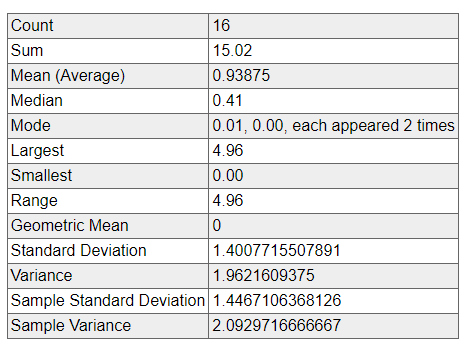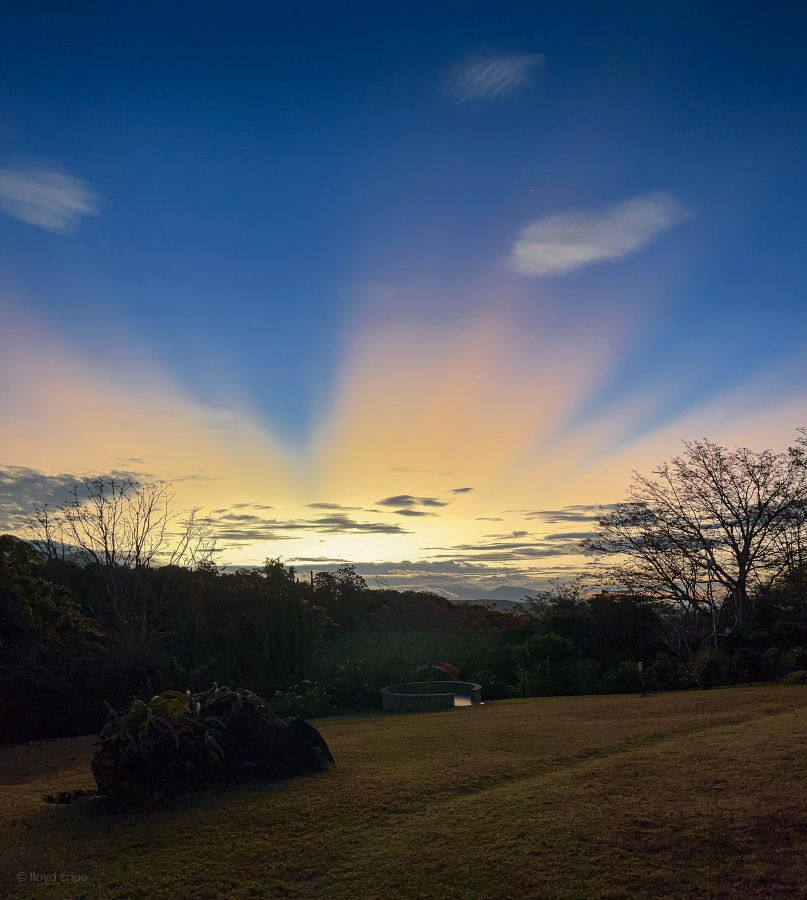| March 3, 2022 | No.155 |
February 2022
(Back Issues Here)
We had very little precipitation (almost none) in February. It was very dry. We had 0.01 inches of rain at the Palmira Arriba Station. The reports from around the District of Boquete for February, in general, indicate very low rainfall throughout the district.
Rainfall for
February 2022 |
|||
Area |
Contributors |
February 2022 |
Total 2022 |
| El Salto Arriba | Beth Corwin | 0.04 | 0.04 |
El Santuario |
Robert Boyd |
2.26 | 2.66 |
| El Santuario | Rodrigo Marciacq | 2.13 | 3.65 |
| Barriade Las Flores | Bill Brick | 1.41 | 2.32 |
Jaramillo Arriba |
Steve Sarner |
1.46 | 2.94 |
| Jaramillo Arriba | Mark Heyer | 1.40 | 2.46 |
| Jaramillo Central | Dave Nichols | 0.70 | 0.99 |
Jaramillo Abajo |
Don Berkowitz |
0.11 | 0.25 |
Jaramillo Abajo |
Bobi McGann |
0.31 | 0.52 |
| Palo Alto | Nancy Pettersen | 4.91 | 7.59 |
| Valle Escondido | Doug Remsen | 0.00 | 0.38 |
Brisas Boquetenas |
Austin Perry |
0.00 | 0.03 |
| Brisas Boquetenas | Dennis DeCorte | 0.02 | 0.71 |
| Brisas Boquetenas | Richard Sturtz | 0.00 | 0.66 |
Los Molinos |
Sela Burkholder |
0.00 | 1.45 |
| El Encanto (Volcancito) | Brian Baldwin | 0.20 | 0.36 |
Cerro Verde (Volcancito) |
Charlotte Lintz |
0.63 | 0.83 |
Santa Lucia |
Paula Litt |
0.09 | 0.15 |
| Caldera | Chris Mccall | 0.00 | 0.49 |
Lucero |
Michael Mullin |
0.00 | 0.00 |
Boquete Country Club |
Paul Arrandale |
0.02 | 0.10 |
Palmira Abajo |
Betty Gray |
0.00 | 0.00 |
Palmira Arriba |
Lloyd Cripe |
0.01 | 0.13 |
| El Banco | Laura Daniels | 0.25 | 1.67 |
Many reports indicate either no rain or near no rain for the month of February 2022.
The highest rainfall was reported by Nancy Pettersen at Palo Alto with 4.91 inches. Several in the north end of the District of Boquete report 1 to 2 inches of precipitation. All of these areas are the ones that get the main hit from the Bajareque coming from the Caribbean side of the mountain range.
At the Palmira Arriba Station we recorded only 0.01 inches of rain for February. This all happened on one day from the Bajareque reaching our area.
Of course the question always is whether or not our month of February was a normal or abnormal month? Let's look at the numbers.
The following chart shows the statistics for the month of February from the years 2007 thru 2022 for the Palmira Arriba Station. The mean rainfall for the month of February is 0.94 inches with a standard deviation of 1.40 inches with a range from 0.00 to 4.96 inches. The rain for February 2022 below the mean but less than a standard deviation so it is statistically within the normal range.
Palmira Arriba Station Rainfall February over 16 Years

We have had several years of February rainfall at or near 0.0 inches. The largest rainfall I have recorded for February was 4.96 inches in 2010.
You can also look at the tables in the Climate Section to see what rains we have had in various months over the course of the last 15 years as well as check the other weather variables.
Bottom line is again that we are in the dry season and February had a low but basically within normal precipitation for the month. We had plenty of wind!
At the end of March, I will calculate the total rainfall for the months of December, January, February and March combined so we can see how this dry season has faired with those of the past. I have the sense that we are having a dry dry season, but this is just a hunch. We will have to see what the numbers say. I will also report more about our winds.
The latest ENSO Cycle Report is saying that "La Niña is present. Equatorial sea surface temperatures (SSTs) are below average across the eastcentral and eastern Pacific Ocean. The tropical Pacific atmosphere is consistent with La Niña. La Niña is likely to continue into the Northern Hemisphere spring (77% chance during March-May 2022) and then transition to ENSO-neutral (56% chance during May-July 2022)." If you check out the report, you will see near the end the U.S. seasonal outlooks which are affected by the ENSO.
Here is a link to a source for understanding El Niño. If you need some help with this, give this a read and you will learn a lot about this important weather phenomenon.
I want to again mention an excellent understandable presentation about El Niño and the ENSO by Mel Strong in his Introduction to Weather and Climate Short Course available on YouTube. I highly recommend this presentation and the entire course. If you listen to just the one lecture on El Niño, you will more clearly understand the ENSO (El Niño Southern Oscillation) system and how it generally affects world weather. He is an exceptional teacher and I find all his lectures in the course to be very informative and uniquely understandable.
The IRI (International Research Institute for Climate and Society) (select South America from the Region menu) is predicting that most of Panama will have a 40%+ probability of normal levels of precipitation for the months of March-April-May 2022 (white-gray).
.gif)
ETESA's hydrology and meteorology section is predicting that Chiriqui will have about average levels of precipitation in most areas of Panama during March of 2022 thru May 2022. You can read their report and check out the details in the "documents" section at this link.
As I previously mentioned, in case you aren't aware of it, you can also watch a daily video report of Panama weather conditions at the ETESA website or on YouTube. Here is the link to their YouTube Channel. If you click the Subscribe button you can get a daily notifications of the report. You can practice your Spanish skills by watching it!
The IPCC (International Panel on Climate Change) just issued "the second part of the Sixth Assessment Report, Climate Change 2022 called "Impacts, Adaptation and Vulnerability" by the Working Group II contribution to the Sixth Assessment Report. It was finalized on 27 February 2022." I plan on reading it in detail in the very near future. It is apparently quite ominous. It is my opinion that the IPCC is the most authoritative and reliable source for understanding the realities of climate change. I think that we should give them our serious attention and our government should apply their recommendations to our Climate Change policies. You can find the report at this link.
All seems to be well with the deployment of the Web Telescope. It is in the process of alignment of the complex mirror system. Your can follow the news about it here.
Another piece of news from NASA I want to share with you is the launch of rocket with a new satellite that is called GOES-T and will monitor extreme weather. It was launched on March 1. You can read about it here. It always amazes me that we have all of these satellites providing us with incredible information and images of our weather. I think we sometimes forget how amazing this is.
On March 2 at 06:15 hours we saw a spectacular sunrise from our finca in Palmira Arriba looking toward the SE. We had actually seen other special sunrises over the last couple of weeks. Here is a photo of the most recent one. Look carefully above one of the clouds on the right where you can see a small speck of light which is the planet Jupiter in the early morning:
(click on image to enlarge)
I think this type of sunrise is partly the result of particulates in the sky from the Saharan Air Layer that comes in at high altitudes with the NE Trade Winds. I have noticed a yellow-brown tint in the morning and evening skies. Regardless of the causes, it was a beautiful moment captured with the camera in my iPhone 13 pro. I was fortunate to be at the right angle and altitude to see it.
COVID INFORMATION
MONITORING CORONAVIRUS STATUS LINKS
At the moment the worldometer reports 441,648,433 cases of COVID worldwide with 5,998,685 deaths and 374,478,682 recovered cases. The USA has 80,791,301 total cases with 980,479 total deaths and 53,978,778 recovered cases. Imagine 5,998,685 dead human beings in the world (most probably an underestimation) and 980,479 of the dead human beings are from the United States. That is a lot of dead people and a very serious matter. This is not just some ordinary flu year. Despite these hard facts, I still come across people who think this is no big deal and they think that wearing masks and getting vaccinated is driven by some sort of governmental conspiracy and it is an infringement of their personal freedoms to cooperate, fall-in-line, and get vaccinated. They try to make a mockery of those dedicated to the science and government of our public health. Such thinking is sheer folly and a stance that is at the height of foolish narcissism and rebellion. I truly don't understand this behavior. This is a public health matter and not a political matter. It is no infringement of personal rights to join together and cooperate for the good of all. That's why we have driver's licenses, wear seatbelts, drive on the required side of the road, and get vaccinated for smallpox (etc.) because responsible government has had the foresight to help and enforce such important things. Public health requires that we cooperate and do things together for our well-being and the well-being of the community. This is no time for stubborn rebelliousness. Don't be contrary. Be cooperative. Some of us humans are contrary enough that we aren't going to do what we need or want to do because somebody else (especially) the government wants us to do it! I think this is pure stubbornness and folly. This is a time for group cooperation and not a time for independent contrariness.
There is some encouraging indication in the U.S. that we are probably moving in a positive direction dealing with COVID. Protective guidance depends on time and data from different regions rather than a one-size-fits-all approach. The evidence is strong that those who are fully vaccinated, are generally protected from serious symptoms and death if they become infected. The unvaccinated are more vulnerable and much more prone to serious symptoms and fatalities if they become infected. The CDC is recommending that the guidance rules for protection can vary depending on the more specific data from the region. Here is a link to the CDC. We aren't out of the woods yet, but we are more hopeful. At present in Panama, we continue with the same protection rules (wear masks in public even if vaccinated).
The biggest challenge during the dry season is not rain, but the wind. Have you noticed? March can be a very windy month. So keep your umbrellas in the closet but always ready for any rain that may come our way during the month. By the way, the average rainfall in March based on my data is 2.37 inches. That is not a lot of rain but better than February's average of less than an inch! You may need that umbrella at times in March.
Lloyd Cripe

